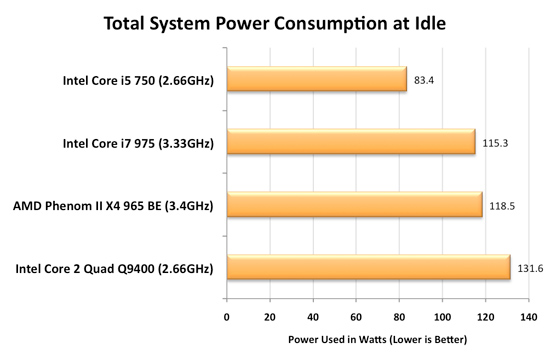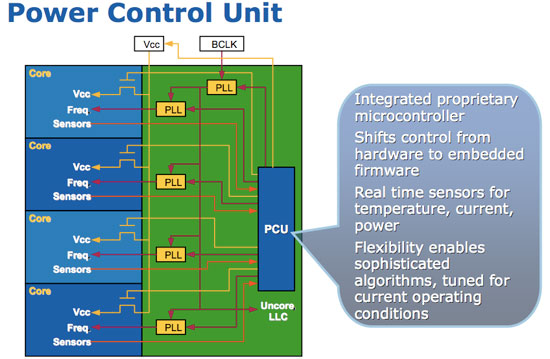Intel's Core i7 870 & i5 750, Lynnfield: Harder, Better, Faster Stronger
by Anand Lal Shimpi on September 8, 2009 12:00 AM EST- Posted in
- CPUs
Homework: How Turbo Mode Works
AMD and Intel both figured out the practical maximum power consumption of a desktop CPU. Intel actually discovered it first, through trial and error, in the Prescott days. At the high end that's around 130W, for the upper mainstream market that's 95W. That's why all high end CPUs ship with 120 - 140W TDPs.
Regardless of whether you have one, two, four, six or eight cores - the entire chip has to fit within that power envelope. A single core 95W chip gets to have a one core eating up all of that power budget. This is where we get very high clock speed single core CPUs from. A 95W dual core processor means that individually the cores have to use less than the single 95W processor, so tradeoffs are made: each core runs at a lower clock speed. A 95W quad core processor requires that each core uses less power than both a single or dual core 95W processor, resulting in more tradeoffs. Each core runs at a lower clock speed than the 95W dual core processor.
The diagram below helps illustrate this:
| Single Core | Dual Core | Quad Core | Hex Core | |
| TDP |  |  |  |  |
| Tradeoff |  |  |  |  |
The TDP is constant, you can't ramp power indefinitely - you eventually run into cooling and thermal density issues. The variables are core count and clock speed (at least today), if you increase one, you have to decrease the other.
Here's the problem: what happens if you're not using all four cores of the 95W quad core processor? You're only consuming a fraction of the 95W TDP because parts of the chip are idle, but your chip ends up being slower than a 95W dual core processor since its clocked lower. The consumer has to thus choose if they should buy a faster dual core or a slower quad core processor.
A smart processor would realize that its cores aren't frequency limited, just TDP limited. Furthermore, if half the chip is idle then the active cores could theoretically run faster.
That smart processor is Lynnfield.
Intel made a very important announcement when Nehalem launched last year. Everyone focused on cache sizes, performance or memory latency, but the most important part of Nehalem was far more subtle: the Power Gate Transistor.
Transistors are supposed to act as light switches - allowing current to flow when they're on, and stopping the flow when they're off. One side effect of constantly reducing transistor feature size and increasing performance is that current continues to flow even when the transistor is switched off. It's called leakage current, and when you've got a few hundred million transistors that are supposed to be off but are still using current, power efficiency suffers. You can reduce leakage current, but you also impact performance when doing so; the processes with the lowest leakage, can't scale as high in clock speed.
Using some clever materials engineering Intel developed a very low resistance, low leakage, transistor that can effectively drop any circuits behind it to near-zero power consumption; a true off switch. This is the Power Gate Transistor.

On a quad-core Phenom II, if two cores are idle, blocks of transistors are placed in the off-state but they still consume power thanks to leakage current. On any Nehalem processor, if two cores are idle, the Power Gate transistors that feed the cores their supply current are turned off and thus the two cores are almost completely turned off - with extremely low leakage current. This is why nothing can touch Nehalem's idle power:

Since Nehalem can effectively turn off idle cores, it can free up some of that precious TDP we were talking about above. The next step then makes perfect sense. After turning off idle cores, let's boost the speed of active cores until we hit our TDP limit.

On every single Nehalem (Lynnfield included) lies around 1 million transistors (about the complexity of a 486) whose sole task is managing power. It turns cores off, underclocks them and is generally charged with the task of making sure that power usage is kept to a minimum. Lynnfield's PCU (Power Control Unit) is largely the same as what was in Bloomfield. The architecture remains the same, although it has a higher sampling rate for monitoring the state of all of the cores and demands on them.
The PCU is responsible for turbo mode.










343 Comments
View All Comments
Jeremiahx99 - Tuesday, February 16, 2010 - link
biased? they where comparing stock vs stock how can u call that biased, and people is not stupid lol whats that mean?BlueBlazer - Sunday, September 13, 2009 - link
Clock to clock comparison with turbo off..http://www.pcper.com/article.php?aid=776&type=...">http://www.pcper.com/article.php?aid=776&type=...
Phenom II 965 comes in last place, due to IPC differences which is why AMD had to release higher clocked (should I say "overclocked") Phenom II to compete against Core 2 and Core i5/i7 series.
MamiyaOtaru - Thursday, September 10, 2009 - link
Why compare to a Phenom OCd by 600mhz? The Phenom doesn't do it automatically like the i7ssj4Gogeta - Thursday, September 10, 2009 - link
It's biased because Intel is giving you more features?? The whole point of comparison is to determine which is better. Next you'll say it's biased because it's comparing a Nehalem to a Phenom II.ClownPuncher - Wednesday, September 9, 2009 - link
"people is not stupid. "Nice
goinginstyle - Wednesday, September 9, 2009 - link
Somebody ban this SnakeOil idiot.Etern205 - Tuesday, September 8, 2009 - link
NDA is lifted! Huzzah!!!philosofool - Tuesday, September 8, 2009 - link
Now all I need is for Newegg to get in on the act!Casper42 - Wednesday, September 9, 2009 - link
http://www.newegg.com/Product/Product.aspx?Item=N8...">http://www.newegg.com/Product/Product.aspx?Item=N8...tcool93 - Tuesday, May 11, 2010 - link
I'm posting this to an older review, but just wanted to make a comment. I noticed all the reviews that have the Q9650 included, compare it to the Phenom 965... which isn't a fair comparison at all, because the Phenom 965 is running at a considerably faster mhz than the Q9650 is. Plus the Q9650 can overclock much faster with no voltage increase. I would bet the Q9650 is faster than the Phenom 965 at the same clock speeds.